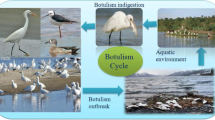Abstract
In this work, two PCR-based methods have been developed for the detection of Clostridium botulinum strains carrying the gene coding for C. botulinum neurotoxin C (BoNTC) responsible for avian botulism. Both methods are based on the same amplification primers designed using multiple sequence alignments between toxin C coding sequences from DNA sequence databases. The first is a real-time PCR method, using a Taqman-MGB probe. The second uses conventional end-point PCR, followed by capillary gel electrophoresis with laser-induced fluorescence detection (CGE-LIF). A comparison between both methods has been established for the individual and simultaneous detection of toxin C (BONTC) or bacterial 16S (BACT) sequences from C. botulinum. The results indicate that, in general, the same sensitivity was achieved by using RT-PCR and PCR-CGE-LIF allowing the detection of both C. botulinum amplicons from concentrations as low as 7 × 10−5 μg/ml of total genomic DNA. Some other features from RT-PCR and CGE-LIF are also critically discussed in this work, including quantification capability, size determination, analysis speed and identification strategies, to provide enough information to adequately select the best analytical technique in each case.




Similar content being viewed by others
Abbreviations
- BACT:
-
Amplicon designed for the detection of bacterial 16S sequences
- BoNTs:
-
Botulinum neurotoxins
- BONTC:
-
Amplicon designed for the detection of Clostridium botulinum neurotoxin C coding sequences
- CGE-LIF:
-
Capillary gel electrophoresis with laser induced fluorescence
- C t :
-
Threshold cycle as used in RT-PCR
- RT-PCR:
-
Real-time PCR
References
Wobeser G (1997) J Wildl Dis 33:181–186
Sandler RJ, Rocke TE, Samuel MD, Yuill TM (2003) J Wildl Dis 29:533–539
Rocke TE, Smith SR, Nashold SW (1998) J Wildl Dis 34:744–751
Fach P, Perelle S, Dilasser F, Grout J, Dargaignaratz C, Botella L, Gourreau JM, Carlin F, Popoff MR, Broussolle V (2002) Appl Environ Microbiol 68:5870–5876
Ferreira JL, Maslanka S, Johnson E, Goodnough M (2003) J AOAC Int 86:314–331
Liu W, Montana V, Chapman ER, Mohideen U, Parpura V (2003) Proc Natl Acad Sci USA 100:13621–13625
Dong M, Tepp WH, Johnson EA, Chapman ER (2004) Proc Natl Acad Sci USA 101:14701–14706
Franciosa G, Fenicia L, Caldiani C, Aureli P (1996) J Clin Microbiol 34:882–885
Williamson JL, Rocke TE, Aiken JM (1999) Appl Environ Microbiol 65:3240–3243
Freeman WM, Walker SJ, Vrana E (1999) Biotechniques 26:112–125
Garcia-Cañas V, Gonzalez R, Cifuentes A (2002) J Agric Food Chem 50:1016–1021
Garcia-Cañas V, Gonzalez R, Cifuentes A (2002) J Sep Sci 25:577–583
Garcia-Cañas V, Gonzalez R, Cifuentes A (2002) J Agric Food Chem 50:4497–4502
Garcia-Cañas V, Macian M, Chenoll E, Aznar R, Gonzalez R, Cifuentes A (2004) J Agric Food Chem 52:5582–5587
Garcia-Cañas V, Gonzalez R, Cifuentes A (2004) TRAC Trend Anal Chem 23:637–643
Garcia-Cañas V, Cifuentes A, Gonzalez R (2004) Crit Rev Food Sci 44:425–436
Cifuentes A (2006) Electrophoresis 27:283–303
Garcia-Cañas V, Cifuentes A, Gonzalez R (2004) Anal Chem 76:2306–2313
Garcia-Cañas V, Gonzalez R, Cifuentes A (2004) Electrophoresis 25:2219–2226
Sang FM, Ren JC (2006) J Chromatogr B 838:122–128
Chenna R, Sugawara H, Koike T, Lopez R, Gibson TJ, Higgins DG, Thompson JD (2003) Nucleic Acids Res 31:3497–3500
Sambrook J, Fritsch EF, Maniatis T (1989) Molecular, cloning: a laboratory manual. Cold Spring Harbor Laboratory Press, Cold Spring Harbor
Nadkarni MA, Martin FE, Jacques NA, Hunter N (2002) Microbiology 148:257–266
Corless CE, Guiver M, Borrow R, Edwards-Jones V, Kaczmarski EB, Fox AJ (2000) J Clin Microbiol 38:1747–1752
Cato EP, George WL, Finegold SM (1998) Genus clostridium. In: Sneath PHA, Mair NS, Holt JG (eds) Bergey's manual of systematic bacteriology, vol 2. Williams and Wilkins, London
Acknowledgments
Authors also thank Dr. Williamson (National Wildlife Health Center, Madison, WI, USA) and Drs. Rosario Muñoz and Blanca de las Rivas (Institute of Industrial Fermentations, CSIC, Madrid, Spain) for kindly providing DNA samples. This work was supported by grants from MEC (AGL2005-05320-C02-01), Comunidad de Madrid (S-505/AGR-0153-ALIBIRD) and Parques Nacionales (MMA, 99/2003).
Author information
Authors and Affiliations
Corresponding author
Electronic supplementary material
Below is the link to the electronic supplementary material.
Rights and permissions
About this article
Cite this article
Sánchez-Hernández, L., Cifuentes, A., Jiménez, B. et al. Detection of Clostridium botulinum neurotoxin coding genes: analysis of PCR products by real time versus capillary gel electrophoresis methods. Eur Food Res Technol 227, 495–502 (2008). https://doi.org/10.1007/s00217-007-0746-1
Received:
Revised:
Accepted:
Published:
Issue Date:
DOI: https://doi.org/10.1007/s00217-007-0746-1




